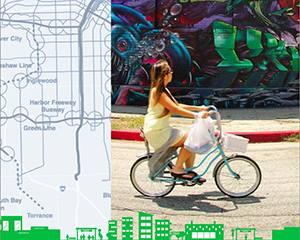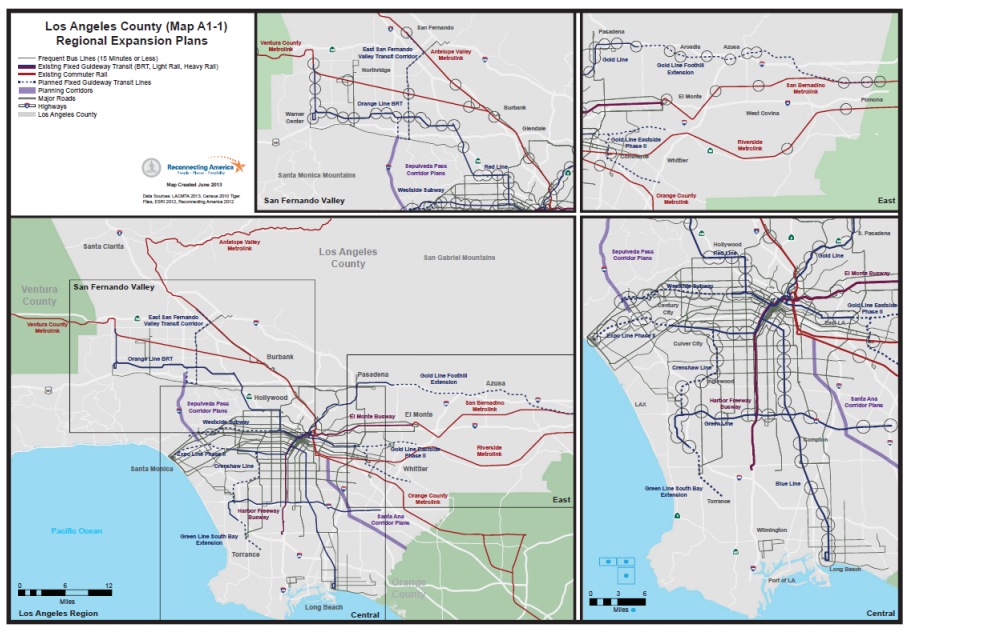CALIFORNIA COMMUNITY FOUNDATION
RECONNECTING AMERICA
Introduction: A New Vision for Los Angeles County
 By 2014, five additional new light rail and subway lines will be under construction across Los Angeles County, part of an unprecedented regional transit expansion unrivaled in the 21st Century in the United States. To some, this investment may harken back to the1950’s and the expansion of the federal highway system, which enticed local leaders in Los Angeles to abandon the expansive transit system that existed at the time to build out a web of highways that have contributed to Los Angeles County’s reputation as a congested, polluted, and auto-centric metropolis. Yet, with a $40 billion voter-approved transit investment being deployed over the next 20 years, along with other critical investments, Los Angeles County residents have decided to chart a path to a new future, redefining how we live, how we move, and how the rest of the world sees and experiences Los Angeles.
By 2014, five additional new light rail and subway lines will be under construction across Los Angeles County, part of an unprecedented regional transit expansion unrivaled in the 21st Century in the United States. To some, this investment may harken back to the1950’s and the expansion of the federal highway system, which enticed local leaders in Los Angeles to abandon the expansive transit system that existed at the time to build out a web of highways that have contributed to Los Angeles County’s reputation as a congested, polluted, and auto-centric metropolis. Yet, with a $40 billion voter-approved transit investment being deployed over the next 20 years, along with other critical investments, Los Angeles County residents have decided to chart a path to a new future, redefining how we live, how we move, and how the rest of the world sees and experiences Los Angeles.
This is an inspiring time to embrace a new vision for Los Angeles County. And, at the same time, it is important to acknowledge where Los Angeles is at this moment in order to implement a plan that is inclusive. The Los Angeles Equity Atlas was developed to help craft a new vision for Los Angeles County’s future. One that embraces the incredible cultural and racial diversity that makes Los Angeles one of the most dynamic and entrepreneurial places in the world, while also acknowledging that many who contribute to that dynamism make up households that are predominantly low and moderate income.
Today, almost three quarters of the “commute to work” trips on the existing transit system are taken by workers earning less than $25,000 a year. These riders are referred to as “core riders” throughout this Equity Atlas. Enticing new riders out of their cars and onto the transit system will be essential in meeting regional goals of improving air quality and reducing congestion, but it is also critically important to ensure that existing core riders of the transit system will further benefit from an improved and expanded transit system. Core riders cannot be a casualty of new investment and the growing desirability of well-connected urban neighborhoods, or the region will not meet its goals.
So, what does equity mean in relation to this $40 billion transit investment? How can the largest voter approved transit initiative in the nation translate into a stronger regional economy, accessible living-wage jobs, reduced congestion, healthier people and places, greater affordability and an overall improved quality of life, particularly for low- and moderate-income people who comprise the majority of the population and workforce in Los Angeles County? The answer largely depends on how policymakers and the public and private sectors resolve tough questions about where and how to allocate investments. This Equity Atlas offers an actionable vision for leveraging the $40 billion in publicly funded transit investments to help realize these outcomes and more.
Download full version (PDF): The Los Angeles Equity Atlas
About the California Community Foundation
www.calfund.org
“The California Community Foundation (CCF) in Los Angeles has been an essential community advocate in the region since 1915. With more than $1 billion in assets, CCF is one of the largest foundations of any kind in the nation. As a community foundation, CCF is a tax-exempt, public nonprofit organization committed to transformative change across Los Angeles and around the world. “
About Reconnecting America
www.reconnectingamerica.org
“Reconnecting America is a national nonprofit that advises civic and community leaders on how to overcome community development challenges to create better communities for all. Reconnecting America develops research and innovative public policy, while also building on-the-ground partnerships and convening players needed to accelerate decision-making.”
Tags: CA, California, California Community Foundation, LA, Light Rail, Los Angeles, Reconnecting America







 RSS Feed
RSS Feed